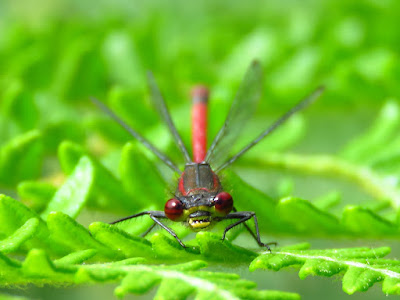 After lunch the clouds started to break open. With the hope of a sunny afternoon I headed to North Cliffe Wood to watch dragonflies. I was hoping to catch up with Large Red Damselflies, one of the earliest species to appear in the spring, which I hadn't seen yet this year.
After lunch the clouds started to break open. With the hope of a sunny afternoon I headed to North Cliffe Wood to watch dragonflies. I was hoping to catch up with Large Red Damselflies, one of the earliest species to appear in the spring, which I hadn't seen yet this year.
As I walked on the entrance path there was an Azure damselfly on the bracken. A four spotted chaser hunted on the heathland. I hadn't even got to the pond when I saw my first Large Red, and many Azures. The heathland pond was the heart of the action: I flushed a male Emperor from the shore, and he hunted for a while over the pond and then disappeared over the heath.
Four spotted chaser, Libellula quadrimaculata.
A settled Four spotted chaser and another one passing by.
Mating Large Red Damselflies
There were so many Azure damselflies, dozens of pairs were egg laying communally, I counted 13 egg laying pairs in one of these photographs. Egg laying appeared to happen on the weedy edges of the pond.
An egg laying aggregation of Azure damselflies.
A mating pair of Azure damselflies.
A view of the pond.
I decided to avoid the woods to minimise being eaten alive by mosquitoes, so I stayed in the heathland. I spotted several hornets, speckled woods and a male brimstone who settled briefly. Many Volucella bombylans on the wing.
Robber fly to ID.
Brimstone.
Sleepy hare on the field.















No comments:
Post a Comment